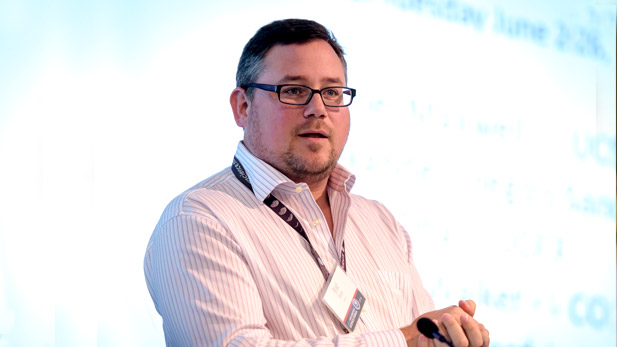Learning from the Moon and Planets

Brad Bailey, a 1998 physics alumnus, has recently taken a new job at NASA headquarters, where he will enable scientific payloads and instrumentation to get down to the lunar surface and help pave the way for humans to return to the moon.
The science legacy of the Apollo missions is yet to be fully realized. Researchers will soon begin studying pieces of the moon that have been carefully stored and untouched for nearly a half century – one of several projects that are providing a framework for future flight missions.
All of this work is being done by NASA’s Solar System Exploration Research Virtual Institute (SSERVI) and its deputy director, Brad E. Bailey, a 1998 physics alumnus. The institute is based at NASA’s Ames Research Center in California.
Teams of researchers will soon begin examining one of the three remaining lunar samples from Apollo missions 15, 16 and 17 that have never been exposed to Earth’s atmosphere. Of particular interest are samples that were vacuum-sealed on the moon after being collected by Apollo 17 astronauts Harrison Schmitt and Gene Cernan in December of 1972. Today’s scientists can’t wait to get their hands on nearly 1.8 pounds of rocks and core samples from below the moon’s surface.
Meanwhile, other researchers will study samples from the moon that have been specially curated, some from Apollo 17 that were kept frozen since being brought to Earth, and samples from Apollo 15 that have been stored in helium since 1971.
“It’s remarkable that we’re still learning lessons from the Apollo space program 50 years later, and what we’re about to learn should help set the course for our future aspirations in space,” says Bailey.
These new scientific studies will prepare for the next era of exploration of the moon and beyond, according to Bailey.
“We need to return to the moon and I’m glad we’re talking about doing it in my lifetime,” he says. “These lunar samples were saved so we can take advantage of today’s analytical techniques and technologies to answer questions we didn’t know how to ask earlier.”
NASA’s SSERVI is a virtual, distributed organization of 13 teams with nearly 500 researchers across 100 institutions throughout the world that are focused on merging scientific and exploration endeavors.
Bailey has spent his entire professional career studying astrobiology and other scientific endeavors at NASA’s Ames Research Center. He has recently taken a new job at NASA headquarters, where he will enable scientific payloads and instrumentation to get down to the lunar surface and help pave the way for humans to return to the moon.
“The merging of science and technology is critical, not only for our return to the moon, but for understanding how to live and work in hostile, other-worldly environments,” Bailey says. “The future of human exploration beyond the Earth-to-moon system relies on the groundwork we are developing right now.”